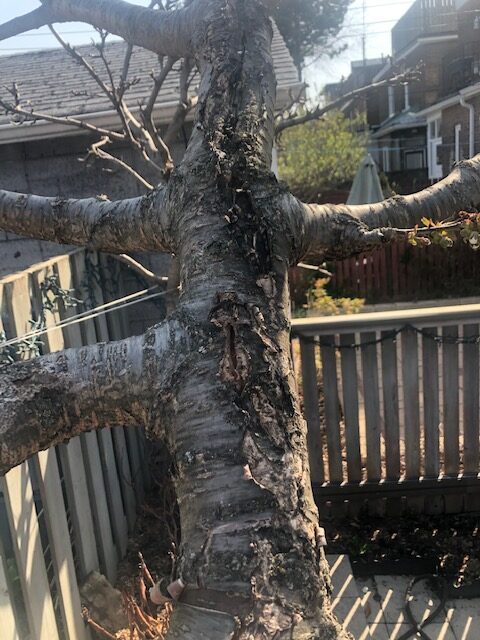
Hello! I have a cherry tree (I don’t know the type) with lesions on the trunk and main branch. These are photos. Any idea of what/how this occurred?
You sent
Thank you for contacting Toronto Master Gardeners about your cherry tree.
Cherry trees are fabulous trees however they are susceptible to a large number of insect and disease problems. Potential diseases include leaf spot, die back, leaf curl, powdery mildew, root rot and fireblight. Potential insects include aphids, scale, borers, leafhoppers, caterpillars, tent caterpillars and Japanese beetles. Spider mites may also be troublesome.
Since there is no picture of the tree with leaves, it is difficult to see if there is any die back from these lesions. Sap oozing from the lesions would indicate gummosis. Please take a look at the following answer from one of our archived posts for information on gummosis and the basic information on the care of cherry trees.
Gummosis, the oozing of sap from a diseased or damaged tree, is a plant’s reaction to stress. It is common in members of the Prunus species which includes cherry trees.
There are many possible causes of gummosis including mechanical injuries, environmental stress, insects, and disease.
Try to identify the source of the tree’s stress. Has the tree been injured mechanically, say by lawn or garden equipment? Is there evidence of insect attack? In these cases, sawdust or pieces of bark will be mixed in the sap.
If insect damage is evident, an arborist may be able to apply a pesticide to control the insects.
From your description, it is quite possible that your tree has succumbed to some type of cherry canker. This is a fungal or bacterial disease spread by spores which enter the tree through injured tissue and then germinate inside.
Unfortunately, there is no easy cure for such diseases.
Pruning out infected wood (during the dormant season) and good cultural practices (adequate water and nutrients, appropriate pruning, protection from winter injury) are typically recommended for such disease management.
If the entire trunk has been infected, your only option may be to remove the tree. This will also reduce the chance that your other tree succumbs to disease too.
I recommend that you contact a professional arborist regarding your next steps. Proper infection control measures during tree removal will be critical.
You can find a certified arborist on the Landscape Ontario site: https://landscapeontario.com/ or on the International Society of Arboriculture (ISA) site https://www.treesaregood.org/findanarborist/findanarborist
Also find some basic information on caring for a Cherry tree – either Prunus avium (sweet cherry) or Prunus cerasus (tart cherry).
Watering: Regular watering using a drip hose is best so as not to wet the tree leaves. Test soil moisture to a depth of 2-3 inches and water only when the soil feels dry at that lower level. Too much moisture can cause root rot and too little will stress the tree, so it’s important to determine how often it needs to be watered. Once there is fruit on the tree, the regularity of watering will increase as the tree needs more moisture to swell the fruit.
Fertilizing: Feeding your tree should be done in the very early spring before bud break. A layer of good quality compost or sheep manure spread all around the tree will help feed it but make sure to keep it away from the tree trunk. After you have done this, spreading 2-3 inches of mulch over top will help retain soil moisture and keep weeds at bay, again keep it away from touching the trunk. It is best to under fertilize rather than over fertilize. If you decide to use a commercial fertilizer, follow the package instructions carefully.
Pruning: A tart cherry tree should need very little pruning because of its natural growth habit but a sweet one will need regular pruning to keep it productive and pest free. Pruning should be done in late autumn, winter or very early spring – after leaf drop and before bud break. Prune out diseased, dead, decaying or dangerous branches as well as branches that cross to begin with, then prune to re-size and shape in order to let air circulate through the tree – this will help with disease & pest control as well as fruit ripening. Pruning tools should be sterilized before and after use on your tree so as not to spread disease.
Diseases: Cherries are susceptible to many ailments such as blight, brown rot, powdery mildew, leaf spot and black knot. Spraying with a commercial copper sulfate spray will help control many of these. Spraying should be done 2 – 3 times over the winter months. Many nurseries or agricultural suppliers will have this, but make sure you follow the package instructions carefully.
Pests: The most common pests that attack Cherries are Aphids, Borers and Scale. Birds are also a really big problem when fruit is ripening and can strip a tree of all fruit in no time at all. Investing in bird netting to cover the tree is very wise if you want to harvest some fruit.
Cherry trees take 5 – 6 years to mature enough where you get a significant harvest so be patient.
Hope this general information is helpful.

